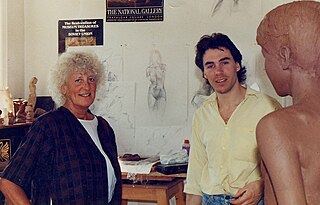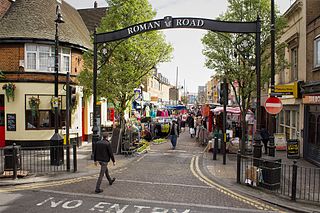History
The legend of the blind beggar became popular in Tudor times and has many variants. [1] One version tells of an English knight, Simon de Montford, who is blinded at the Battle of Evesham in 1265. Seeking to conceal his identity, he begs alms at Bethnal Green, while his beautiful daughter Besse is wooed by four suitors, three of whom are discouraged by her father's seeming inability to provide a dowry. The fourth recognises Besse's innate nobility and marries her anyway, whereupon he receives a dowry from her still-wealthy father. [2] Bethnal Green's civic coat of arms bears the images of Besse and her blind father and the legend is commemorated in many place names in the area, including that of The Blind Beggar public house on Whitechapel Road. [3]
Post-war reconstruction of Bethnal Green, which had suffered severely in the Blitz was led by the architectural team of Skinner Bailey & Lubetkin, the successor to Berthold Lubetkin's Tecton Group. The Cranbrook estate was the last and the largest of the three housing estates they designed. The sculpture of the Blind Beggar was commissioned by Bethnal Green Council in 1957, and was awarded to the then 27 year-old sculptor Elisabeth Frink. It was first sited on Roman Road, from where it can still be seen, but was moved to its intended location in Tate Garden in 1963. [5]

Bethnal Green is an area in London, England and is located in the London Borough of Tower Hamlets. It is in east London and part of the East End. The area emerged from the small settlement which developed around the Green, much of which survives today as Bethnal Green Gardens, beside Cambridge Heath Road. By the 16th century the term applied to a wider rural area, the Hamlet of Bethnal Green, which subsequently became a Parish, then a Metropolitan Borough before merging with neighbouring areas to become the north-western part of the new Tower Hamlets.

Bethnal Green was a civil parish and a metropolitan borough of the County of London between 1899 and 1965, when it was merged with the Metropolitan Borough of Stepney and the Metropolitan Borough of Poplar to form the London Borough of Tower Hamlets.

Bow is a district in East London, England and is in the London Borough of Tower Hamlets. It is an inner-city suburb located 4.6 miles (7.4 km) east of Charing Cross.

Dame Elisabeth Jean Frink was an English sculptor and printmaker. Her Times obituary noted the three essential themes in her work as "the nature of Man; the 'horseness' of horses; and the divine in human form".

The Blind Beggar is a pub in Whitechapel Road in the East End of London, England, at the junction with Cambridge Heath Road.

Berthold Romanovich Lubetkin was a Georgian-British architect who pioneered modernist design in Britain in the 1930s. His work includes the Highpoint housing complex, the Penguin Pool at London Zoo, Finsbury Health Centre and Spa Green Estate.

Old Ford is an area in the London Borough of Tower Hamlets that is named after the natural ford which provided a crossing of the River Lea.

The Cranbrook Estate is a housing estate in Bethnal Green, London, England. It is located next to Roman Road and is based around a figure of eight street called Mace Street. The estate was designed by Francis Skinner, Douglas Bailey and an elder mentor, the Soviet émigré Berthold Lubetkin.
Patricia Maureen Grayburn, MBE, DL has a long involvement with the arts in Surrey after moving to become Arts Administrator at University of Surrey in 1983.

St Peter's Bethnal Green is a 19th-century church in Bethnal Green, London, England.

Robert Ernest Clatworthy RA was a British sculptor and teacher of art. He was head of the fine art department at the Central School of Art and Design in London from 1971 to 1975, and was elected a fellow of the Royal Academy of Arts in 1973.

Roman Road is a road in East London, England, in the London Borough of Tower Hamlets entirely on the B119 on the B roads network. It lies on the old Roman Pye Road of the Roman Empire running from the capital of the Iceni at Venta Icenorum to Londinium and today hosts a street market. Beginning in Old Ford at its eastern end, it passes into Bethnal Green to its western end.

The Rarest Ballad That Ever Was Seen is an English broadside ballad from the late 17th century. It tells the story of a blind beggar's daughter from Bednal-Green and her marriage to a knight.

St Casimir's Lithuanian Church is in Bethnal Green, London, England.

Horse and Rider is a 1974 bronze equestrian sculpture by Elisabeth Frink. The work was commissioned for a site in Mayfair; another cast is in Winchester. It was described by Frink as "an ageless symbol of man and horse".

Mulberry Place, formerly Tower Hamlets Town Hall, is a building in Nutmeg Lane, Blackwall, London. It was the headquarters of Tower Hamlets London Borough Council from 1992 to 2023, before their relocation to the new Tower Hamlets Town Hall in Whitechapel Road.

John Dixon Butler was a British architect and surveyor who had a long, professional association with London's Metropolitan Police. During his 25-year career with the police, he completed the designs and alterations to around 200 police buildings, including ten courts; as of 2022, about 58 of his buildings survive. Historic England describes him as "one of the most accomplished Metropolitan Police architects" and have included around 25 of his buildings on the National Historic List of England and Wales.

The statue of Winston Churchill in Woodford, London, is a bronze sculpture of the British statesman, created by David McFall in 1958–9. The statue commemorates Churchill's role as the member for the parliamentary constituency of Woodford. Churchill was elected to the Epping seat in 1924 and held it until 1945 when the new constituency of Woodford was created. Churchill then held this seat until his retirement in 1964. The statue is a Grade II listed structure.
This page is based on this
Wikipedia article Text is available under the
CC BY-SA 4.0 license; additional terms may apply.
Images, videos and audio are available under their respective licenses.

















